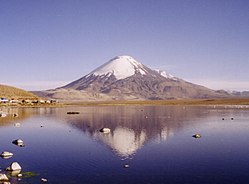Arica y Parinacota
|
Arica and Parinacota Region XV Región de Arica y Parinacota |
|||
|---|---|---|---|
| Region of Chile | |||
 |
|||
|
|||
 Map of Arica and Parinacota Region |
|||
| Coordinates: 18°28′30″S 70°18′52″W / 18.47500°S 70.31444°WCoordinates: 18°28′30″S 70°18′52″W / 18.47500°S 70.31444°W | |||
| Country |
|
||
| Capital | Arica | ||
| Provinces | Arica, Parinacota | ||
| Government | |||
| • Intendant | Gladys Acuña | ||
| Area | |||
| • Total | 16,873.3 km2 (6,514.8 sq mi) | ||
| Area rank | 12 | ||
| Highest elevation | 6,342 m (20,807 ft) | ||
| Lowest elevation | 0 m (0 ft) | ||
| Population (2012) | |||
| • Total | 213,595 | ||
| • Rank | 13 | ||
| • Density | 13/km2 (33/sq mi) | ||
| ISO 3166 code | CL-AP | ||
| Website | Official website (Spanish) | ||
The XV Arica and Parinacota Region (Spanish: XV Región de Arica y Parinacota pronounced: [aˈɾika i paɾinaˈkota]) is one of Chile's 15 first order administrative divisions. It borders Peru to the north, Bolivia to the east and Chile's Tarapacá Region to the south. It is also the country's newest region, created under Law No. 20,175. It became operational on October 8, 2007. Chile's former Tarapacá region was a former Peruvian province, which was occupied by Chile under the 1883 Treaty of Ancón at the close of the War of the Pacific, and then formally annexed in 1929 by the Treaty of Lima.
In 2007, the region was subdivided to create the Arica y Parinacota region and the present day Tarapacá Region to the south. The region is further subdivided into two provinces: Arica and Parinacota.
According to data from the 2002 Census of INE, the region is populated by 189 644 inhabitants. Its density reaches 11.2 inhabitants per km ².
This region holds the largest population of Aymara and a significant number of immigrants from neighboring Peru and Bolivia. Included are those of Asian descent, such as Chinese and Japanese; and Arabs from Lebanon, Palestine and Syria. Most of the country's Afro-Chileans live in the Arica province, descended from slaves in the 17th and 18th centuries. There are a large number of Roma people or Gypsies in the Arica province as well, originated from Eastern Europe in the late 19th century.
...
Wikipedia


